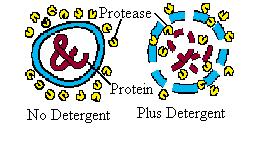Cell biology/Membrane Structure: Proteins
Appearance
Here is the link to the ITunes U Lecture from Berkeley. Membrane Structure: Proteins
- Phospholipids will create a membrane, called a vesicle, spontaneously when you add phospholipid molecules into an aqueous solution.
- Phase Transition graphs can be used to determine the flexibility of different phospholipids at different temperatures.
Fatty acid chains determine the flexibility of the membrane.
[edit | edit source]- Shorter fatty acid chains prefer a liquid.
- Longer fatty acid chains prefer a solid state.
- Double bonds make fatty acid chains prefer a liquid state.
- Bacteria have enzymes that adapt to changing temperatures. If you increase the temperature of the bacteria, the bacteria will use enzymes to increase the length of the phospholipid chains and decrease the number of double bonds.
Cholesterol alters the phase transition of membranes.
[edit | edit source]- It smooths out the liquid-solid transition at higher temperatures, because the hard rod structure of cholesterol prevents liquid movement.
- It also smooths out the liquid-solid transition at lower temperatures because the cholesterol gets in the way of the phospholipid formation of a crystalline structure.
- Peripheral proteins can be removed by changes in salt level, pH, divalent cation levels (i.e. Ca++), and diseases of the red blood cell shape.
- Sickle Cell Anemia causes hemoglobin to clump in the middle of the cell preventing shape changes when the red blood cells are forced through capillaries. (The peripheral protein, spectrin, is responsible for the shape of red blood cells).
- Hereditary Spherocytosis is a genetic disorder that causes red blood cells to take a spherical rather than biconcave shape.

- Integral Proteins cannot be removed from the membrane without using a detergent to solubilize the lipids freeing the protein.
- A nonionic detergent is needed to bind to the protein without denaturing the protein.
- Triton X100 when added to a buffer a micelle forms. A micelle is an apolar chain fills the inside while the outside the polar heads interact with the aqueous solution.
- The micelles embed into a membrane and form bonds around the protein so the nonpolar regions of the protein are protected from the solution.
- A variety of detergents are needed for different proteins.
- A nonionic detergent is needed to bind to the protein without denaturing the protein.
Studying Proteins
[edit | edit source]- A membrane can be broken apart and phospholipids can be removed. These phospholipids can be rehydrated to form a vesicles with a lipid bilayer.
- Proteins can be reconstituted in vesicles but in an experiment the protein can be created facing the wrong direction (unlike in a cell where the protein is placed into the membrane).
- To figure out how many proteins are oriented backwards a radioactive substrate can be utilized. The laboratory created vesicles with protein can be tested with this substrate in the presence or absence of detergents. Detergents will allow all of the proteins to function (and the radioactive substrate will be consumed and found within proteins) while the sample without detergents will only allow the proteins facing the outside to work on the substrate. Comparing the values of the two samples will provide the percent of correctly oriented proteins. This test is called a latency experiment.
- A modification of this experiment, called protease protection, is used extensively to study proteins. In this experiment, to find the location of proteins, laboratory created endoplasmic reticulum vesicles are used and radioactive amino acid are provided. One sample is then treated with trypsin and the other treated with trypsin and detergent. If the amino acids are inside the vesicle the trypsin will be unable to act upon them without the presence of a detergent.
- This procedure can be used to find conditions that allow the protein to face the correct direction. The optimal conditions would create proteins that acted on as many substrates without detergent present as with detergent present.
Please feel free to add details or make changes where necessary. Contact me via email if you need help. Thanks, April



